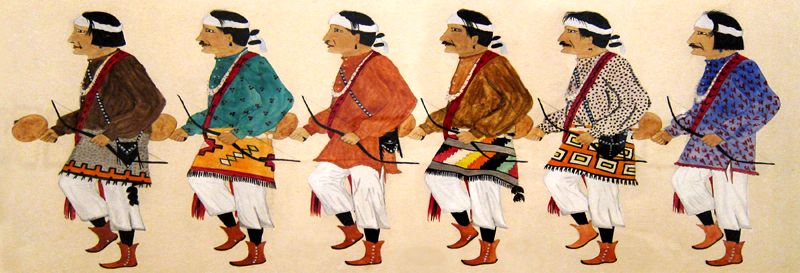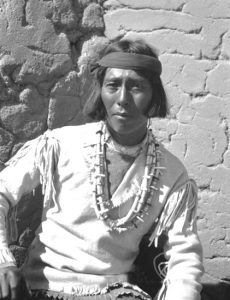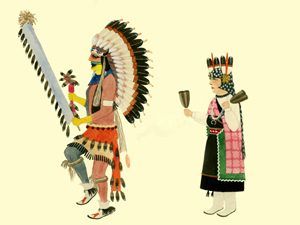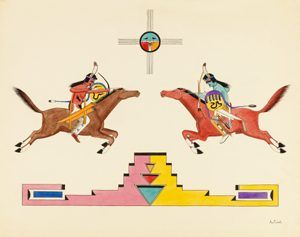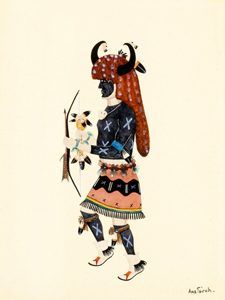Awa Tsireh, also known as Alfonso Roybal and Cattail Bird, was one of the first Pueblo painters to receive recognition by the Santa Fe, New Mexico art community. Awa Tsireh was his Tewa Indian name, while Alfonso Roybal was his family name.
Awa Tsireh was born to Juan Estevan Roybal and Alfoncita Martinez on February 1, 1898, at the San Ildefonso Pueblo, New Mexico. His maternal grandfather was a full-blooded Diné of the Navajo Nation who had been adopted as an infant into the pueblo.
His family was very active in the arts. His father was the nephew of Cresencio Martinez, who was well known for his paintings on pottery, and his mother was a pottery maker. He was educated in his village and was inspired to paint by his uncle, whom he soon surpassed in graphic skills. His formal education ended at grade school, but he drew from his culture and informal training.
After seeing several examples of Awa Tsireh’s work for sale in a souvenir shop in 1917, Alice Corbin Henderson, the wife of artist William P. Henderson, sought out the artist and developed a great respect for his work and that of his peers. Although few were sold for more than a dollar, Awa Tsireh’s success at selling his paintings encouraged other Pueblo artists to adapt their painting and design skills to the medium of watercolor paint on paper. Edgar L. Hewett soon commissioned him to make paintings of Indian ceremonies. This brought him into daily contact at the School of American Research, then a branch of the Museum of New Mexico, with Indian painters Fred Kabotie, a Hopi artist, Velino Shije Herrera of Zia, and artist William P. Henderson, who occupied studios there. In the 1920s, Awa Tsireh received a sponsorship from the School of American Research to devote himself to full-time painting.
In the meantime, Elizabeth Willis DeHuff, the wife of the Superintendent Santa Fe Indian School, became involved with the community surrounding the school. A teacher by trade, she became an art instructor, particularly painting, due to the Bureau of Indian Affairs prohibiting arts training. Holding classes in her own home, she taught students from several area tribes, including Fred Kabotie, Otis Polelonema, Velino Shije Herrera, Awa Tsireh, and several others. As an instructor, her contributions helped to help represent the visual arts by the area Indians and develop the southwest Movement of Native American painting. The work of DeHuff’s students was displayed at the Museum of New Mexico in 1919, and museum director Edgar Lee Hewett hired Herrera and other artists for various jobs at the museum and the School of American Research.
In 1920 Awa Tsireh married a young woman from his village. She gave birth to a son the following year, but both mother and child died soon after. Affected greatly, Awa Tsireh moved to his parent’s home.
By the 1930s, after Tsireh’s work had appeared in major exhibitions of Indian art in Chicago and New York, Awa enjoyed a national reputation. He produced decorative paintings of extraordinary precision with India ink and a brilliant, distinctive palette. His style developed from naive realism to depict genre and dance scenes through more abstract phases featuring landscape “props” and stylized animal forms.
It is unknown when, or from whom, Awa Tsireh learned silversmithing, but by 1931 newspaper articles described him as a painter, silversmith, and dancer. Around 1930 he began working in the summer months at Garden of the Gods Trading Post in Colorado Springs, Colorado, and continued to work there for the next two decades.
Awa Tsireh had a profound influence on the work of many other artists, who were inspired by his wide range of subject matter, the delicacy of craftsmanship, color variations, and preservation of indigenous design elements. He primarily worked in watercolor and transparent colored ink and pencil. His work in metal included silver, copper, nickel silver, and aluminum and often included gemstones.
By 1950, according to El Palacio magazine, he had abandoned his painting, silversmithing, and other unrelated jobs due to poor eyesight, shaky hands, and other personal reasons. He died on March 30, 1955, at the San Ildefonso Pueblo.
Today, his work is held by several museums, including the Smithsonian American Art Museum. His nephew José Disiderio “J.D.” Roybal also became a painter.
© Kathy Alexander/Legends of America, updated December 2021.
Also See:
Sources:
Dutton, Bertha Pauline; American Indians of the Southwest, University of New Mexico Press, 1983
Smithsonian American Art Museum
Wikipedia

